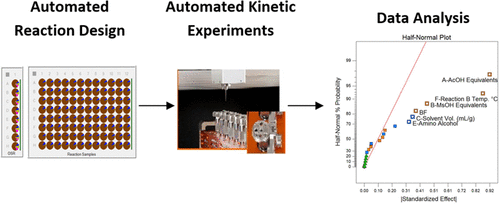当前位置:
X-MOL 学术
›
Org. Process Res. Dev.
›
论文详情
Our official English website, www.x-mol.net, welcomes your
feedback! (Note: you will need to create a separate account there.)
High-Throughput Automated Design of Experiment (DoE) and Kinetic Modeling to Aid in Process Development of an API
Organic Process Research & Development ( IF 3.1 ) Pub Date : 2017-12-22 00:00:00 , DOI: 10.1021/acs.oprd.7b00295 Christopher Nunn 1 , Andrew DiPietro 1 , Neil Hodnett 1 , Pu Sun 2 , Kenneth M. Wells 1
Organic Process Research & Development ( IF 3.1 ) Pub Date : 2017-12-22 00:00:00 , DOI: 10.1021/acs.oprd.7b00295 Christopher Nunn 1 , Andrew DiPietro 1 , Neil Hodnett 1 , Pu Sun 2 , Kenneth M. Wells 1
Affiliation

|
A Design of Experiment (DoE) and kinetic screening study was carried out using an automated reaction screening platform, and as a case study, an early stage in the synthesis of a late phase developmental candidate was investigated. Key impurities were tracked and kinetically modeled, and significant factors impacting impurity formation were identified. In particular, factors that influence the formation of the diastereomer 4, a precursor to an API impurity identified as a Critical Quality Attribute (CQA), were identified and optimized to minimize its formation. Acetic acid, methanesulfonic acid, volumes of solvent, amino alcohol, and reaction B temperature were observed to be the most significant factors along with a factor interaction between methanesulfonic acid and the reaction B temperature. From the experimental data, diastereomer levels of 2.5–5.4 mol % were observed and a kinetic model was developed around the diastereomer formation. Good agreement between the model and experimental data gave confidence in understanding the contributing factors of diastereomer generation, and enabled confirmation of process parameter recommendations to support risk assessments and Quality by Design (QbD) activities. In total, automation provided a 4–5 times savings in FTE hours over a manual process when conducting these experiments and greatly accelerated the generation of supporting information for a drug file.
中文翻译:

高通量自动化实验设计(DoE)和动力学建模,有助于API的流程开发
使用自动反应筛选平台进行了实验设计(DoE)和动力学筛选研究,并作为案例研究,研究了后期发育候选物的合成的早期阶段。跟踪关键杂质并进行动力学建模,并确定了影响杂质形成的重要因素。特别是影响非对映异构体4形成的因素确定并优化了API杂质(被确定为关键质量属性(CQA))的前体,以最大程度地减少其形成。观察到乙酸,甲磺酸,溶剂体积,氨基醇和反应B温度是最重要的因素,同时甲磺酸与反应B温度之间也存在相互作用。根据实验数据,观察到非对映异构体的含量为2.5–5.4 mol%,并围绕非对映异构体的形成建立了动力学模型。模型与实验数据之间的良好一致性使我们有信心了解非对映异构体生成的影响因素,并能够确认工艺参数建议,以支持风险评估和“设计质量”(QbD)活动。总共,
更新日期:2017-12-22
中文翻译:

高通量自动化实验设计(DoE)和动力学建模,有助于API的流程开发
使用自动反应筛选平台进行了实验设计(DoE)和动力学筛选研究,并作为案例研究,研究了后期发育候选物的合成的早期阶段。跟踪关键杂质并进行动力学建模,并确定了影响杂质形成的重要因素。特别是影响非对映异构体4形成的因素确定并优化了API杂质(被确定为关键质量属性(CQA))的前体,以最大程度地减少其形成。观察到乙酸,甲磺酸,溶剂体积,氨基醇和反应B温度是最重要的因素,同时甲磺酸与反应B温度之间也存在相互作用。根据实验数据,观察到非对映异构体的含量为2.5–5.4 mol%,并围绕非对映异构体的形成建立了动力学模型。模型与实验数据之间的良好一致性使我们有信心了解非对映异构体生成的影响因素,并能够确认工艺参数建议,以支持风险评估和“设计质量”(QbD)活动。总共,









































 京公网安备 11010802027423号
京公网安备 11010802027423号